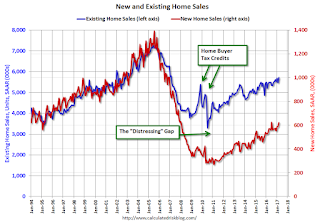by Calculated Risk on 4/25/2017 11:59:00 AM
Tuesday, April 25, 2017
A few Comments on March New Home Sales
New home sales for March were reported at 621,000 on a seasonally adjusted annual rate basis (SAAR). This was well above the consensus forecast, and the three previous months combined were revised up significantly. This was a strong report.
Sales were up 15.6% year-over-year in March. However, January, February and March were the weakest months last year on a seasonally adjusted annual rate basis - so this was an easy comparison.
So far the increase in mortgage rates has not negatively impacted new home sales.
Earlier: New Home Sales increase to 621,000 Annual Rate in March.

This graph shows new home sales for 2016 and 2017 by month (Seasonally Adjusted Annual Rate). Sales were up 15.6% year-over-year in March.
For the first three months of 2017, new home sales are up 12.0% compared to the same period in 2016.
And here is another update to the "distressing gap" graph that I first started posting a number of years ago to show the emerging gap caused by distressed sales. Now I'm looking for the gap to close over the next several years.

Following the housing bubble and bust, the "distressing gap" appeared mostly because of distressed sales. The gap has persisted even though distressed sales are down significantly, since new home builders focused on more expensive homes.
I expect existing home sales to move more sideways, and I expect this gap to slowly close, mostly from an increase in new home sales.
However, this assumes that the builders will offer some smaller, less expensive homes. If not, then the gap will persist.

This ratio was fairly stable from 1994 through 2006, and then the flood of distressed sales kept the number of existing home sales elevated and depressed new home sales. (Note: This ratio was fairly stable back to the early '70s, but I only have annual data for the earlier years).
In general the ratio has been trending down since the housing bust, and this ratio will probably continue to trend down over the next several years.
Note: Existing home sales are counted when transactions are closed, and new home sales are counted when contracts are signed. So the timing of sales is different.


